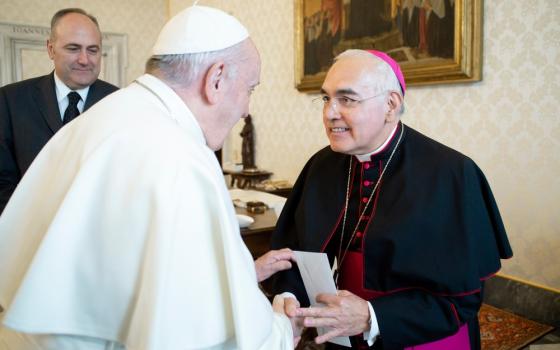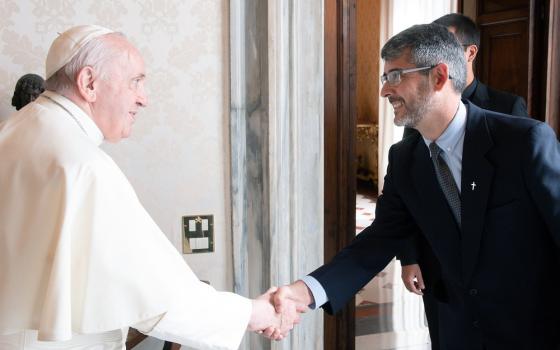I’ve gotten a small flood of e-mails and referrals to blogs about the final Vatican approval of the new Roman Missal, Third Edition, for liturgical use in the United States.
Cardinal Francis E. George of Chicago, president of the U.S. Conference of Catholic Bishops, announced Aug. 20 that the final approval of all Mass texts for the U.S. had been received.
He decreed that use of the new Missal will begin the first Sunday of Advent, Nov. 27, 2011. Presumably that actually means Saturday evening, Nov. 26, when the first Sunday Masses of Advent are celebrated. (A bit more on this later.)
One of the hot topics in the arcane blogosphere of People Who Quibble over Latin Translations is what editorial changes the Vatican has made to the ordinary parts of the Mass between its 2008 approval of those texts (recognitio, or “recognition,” is the formal canonical term) and the final version approved in 2010.
The most important change between 2008 and 2010, in my opinion, is the reinsertion of “I believe” three extra times in the English version of the Creed, where the Latin and Greek texts use it only once.
That change means that the Vatican has finally recognized that at least in some cases English syntax sometimes does not mesh with Latin -- a principle almost entirely lacking in the Vatican Congregation for Divine Worship and the Sacraments’ 2001 decree on liturgical renewal, Liturgiam Authenticam.
In Latin, the liturgical version of the Nicene Creed begins with Credo (“I believe”) followed by in unum Deum … et in unum Dominum … et in Spiritum Sanctum … et unam, sanctam, catholicam et apostolicam ecclesiam -- “I believe in one God … and in one Lord … and in the Holy Spirit … and one, holy, catholic and apostolic church” -- making one extremely long sentence.
In Greek Catholic and Orthodox liturgical usage, it is also one long sentence: Pisteuo eis ena Theon … kai eis ena Kurion … kai eis to Pneuma to Hagion … eis mian, hagian, katholiken kai apostoliken ekklesian – “I believe in one God … and in one Lord … and in the Holy Spirit … in one, holy catholic and apostolic church.”
In the original Greek texts of the Creed approved by the Councils of Nicaea (325 A.D.) and Constantinople (which in 381 A.D. made a slight addition to the Nicene text), “We believe” (pisteuomen) was used, reflecting the collective belief of those council fathers in the faith they held in common.
For many decades now, U.S. Catholics have been praying, “We believe in one God … we believe in one Lord … we believe in the Holy Spirit … we believe in one, holy, catholic and apostolic church.”
Purists on one side have argued that the original conciliar texts of the fourth-century councils, using the first-person plural, should hold sway.
They have on their side the historic council texts that say “We believe,” not “I believe.”
The 2008 Vatican-approved text for U.S. (and other English-language) liturgical use reverted to “I believe,” again making it a personal rather than communal act of faith.
But hold the phones on this controversy: For centuries the Byzantine and other Eastern churches -- both Orthodox and Catholic -- have been using the singular version, “I believe” – pisteuo, not pisteuomen -- for their liturgical recitation of the Nicene Creed, just as the Latin Church used the singular, credo, not credimus.
So the vote seems to be pretty clear: the perennial liturgical usage in both the Latin and Eastern liturgies favors the use of “I” rather than “we” in the Creed.
But hold the phones again: The Catechism of the Catholic Church, issued in 1994, says in paragraph 167: “ ‘I believe’ (Apostles’ Creed) is the faith of the church professed personally by each believer, principally during baptism. ‘We believe’ (Niceno-Constantipolitan Creed) is the faith of the church confessed by the bishops assembled in council or more generally by the liturgical assembly of believers.”
In other words, the church’s official catechism seems to say “we” is preferable in the liturgical version of the Nicene Creed as a profession of the assembled believers.
How do we square this assertion in a Vatican doctrinal text, which the catechism is, with the decision of Liturgiam Authenticam to mandate liturgical use of the “I” form for the Nicene Creed in all modern translations? As a mere reporter, I don’t know the answer: I can only raise the question.
Apart from the Creed, The changes between what the Vatican approved in 2008 and then revised in 2010 are pretty minor.
For example, for the absolution formula at the end of the penitential rite, the 2008 version had the priest saying, “May almighty God have mercy on us and lead us, with our sins forgiven, to eternal life.” This was a very literal, but in English also very awkward, translation of the Latin, “Misereatur nostri omnipotens Deus et, dimissis peccatis nostris, perducat nos ad vitam aeternam. ” The revision approved in 2010 gives us back the more familiar English version: “May almighty God have mercy on us, forgive us our sins, and bring us to everlasting life.”
Another small change: in Eucharistic Prayer I, the 2008 version translated in primis as “first of all,” while the 2010 version says “firstly.” At another point, quaesumus was translated as “we beg” in 2008 but changed to “we beseech” in 2010. Virtually all of the changes between 2008 and 2010 are that small.
A little footnote on a trivia question I raised earlier: when the new English version of the Missale Romanum, Editio Tertia, will take effect in the United States.
Back in 1983, when the new Code of Canon Law took effect on the first Sunday of Advent, Canon 1248 made it a general church law that Catholics could fulfill their Sunday Mass obligation on Saturday evening. Until then, such an option had been available only if the local bishop approved it.
Cardinal John Krol of Philadelphia, an eminent canon lawyer, was the last U.S. holdout against Saturday evening Masses serving to meet Sunday Mass obligations for Catholics in his archdiocese, and for years some Philadelphia Catholics had crossed the Delaware River to the Diocese of Camden, N.J., for Saturday evening Masses. Shortly before the new code took effect, Krol announced that parishes in his archdiocese could begin scheduling Saturday evening Masses on the eve of the first Sunday of Advent that year -- even though the new code itself expressly took effect only the next day. Liturgically, those Saturday evening Masses were the same as Sunday Masses.
Based on that canonical precedent, I would assume that the new Roman Missal, Third Edition, will actually take effect liturgically on the evening of Saturday, Nov. 26, 2011, with the First Sunday of Advent Masses that are celebrated that day, not on the civil calendar day of Nov. 27.
[Jerry Filteau is NCR Washington correspondent.]



